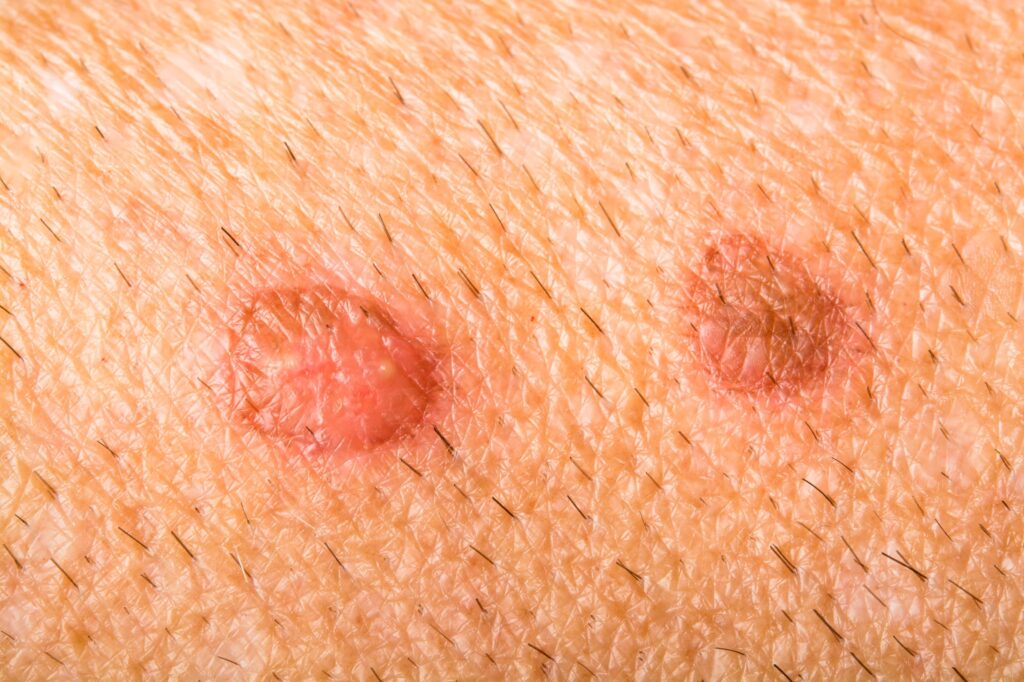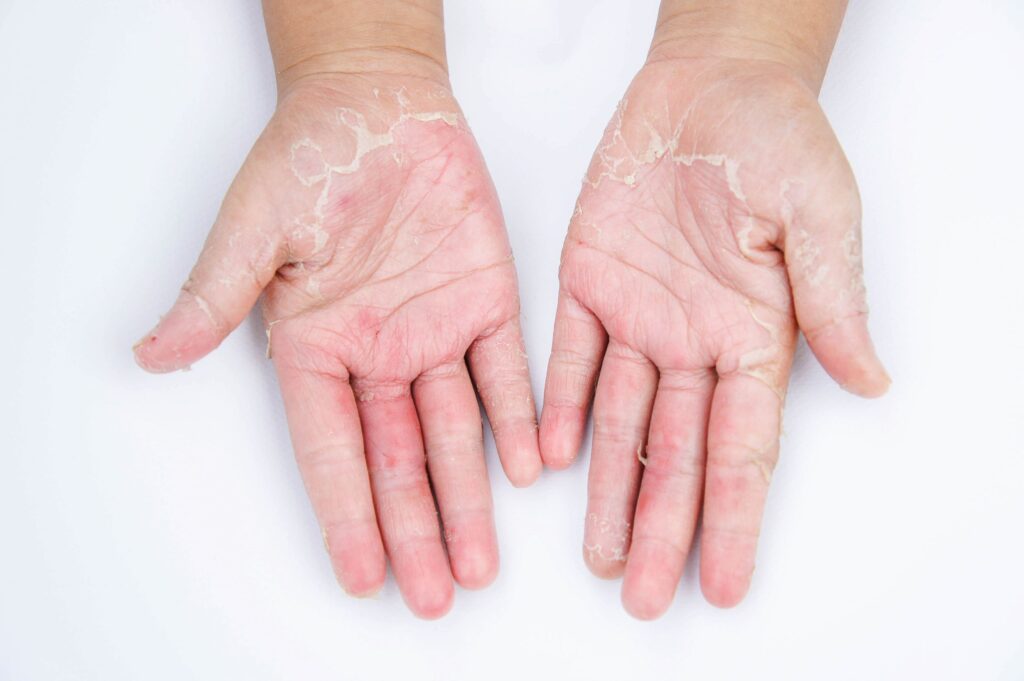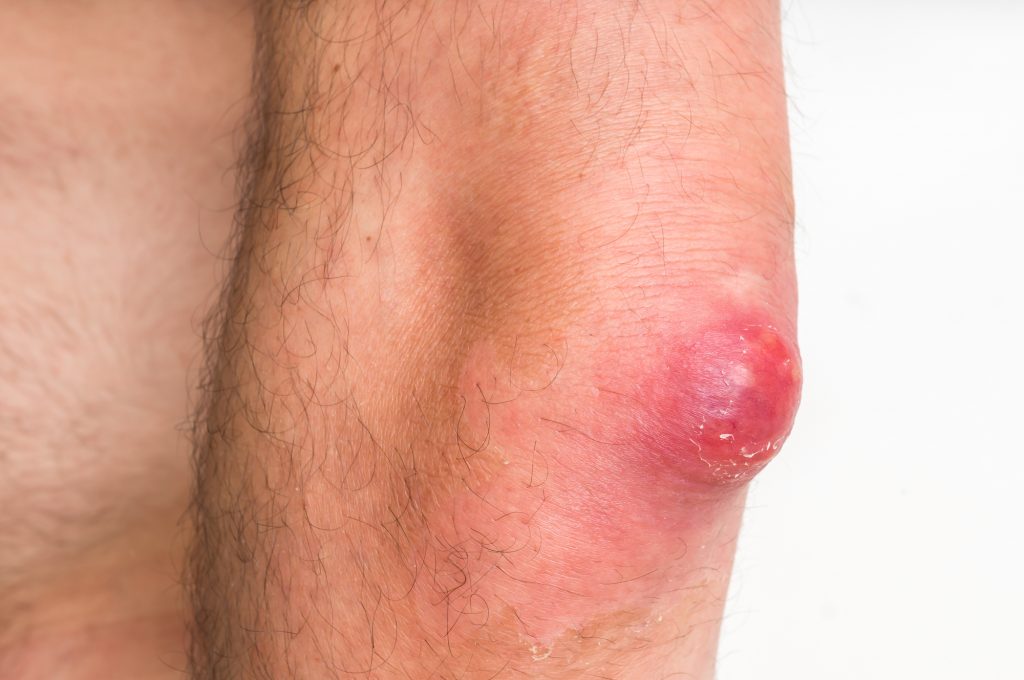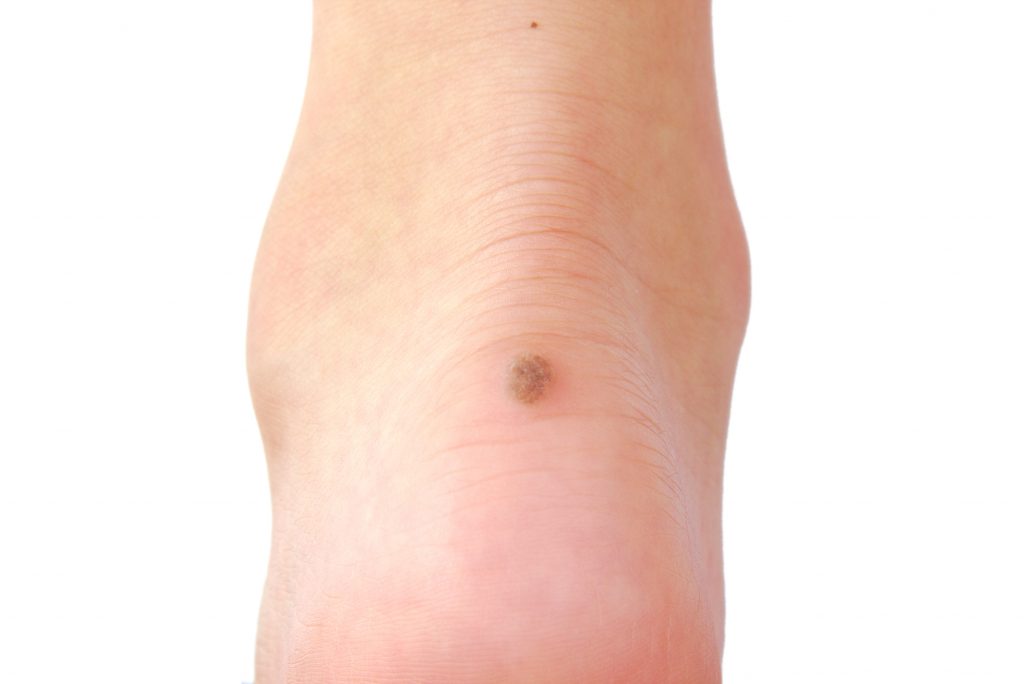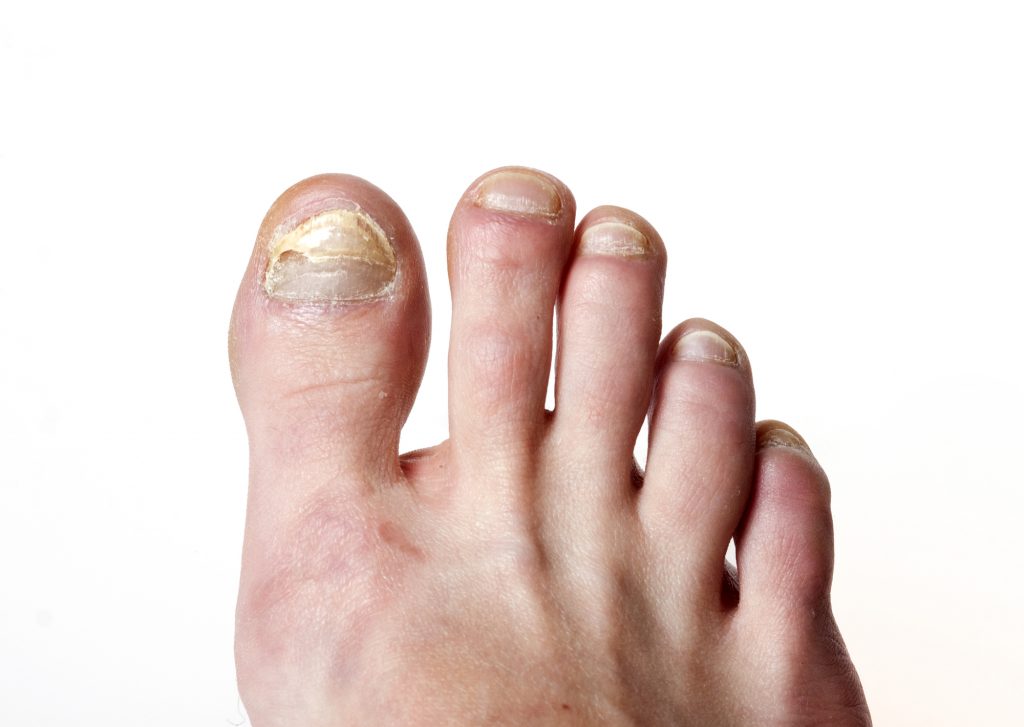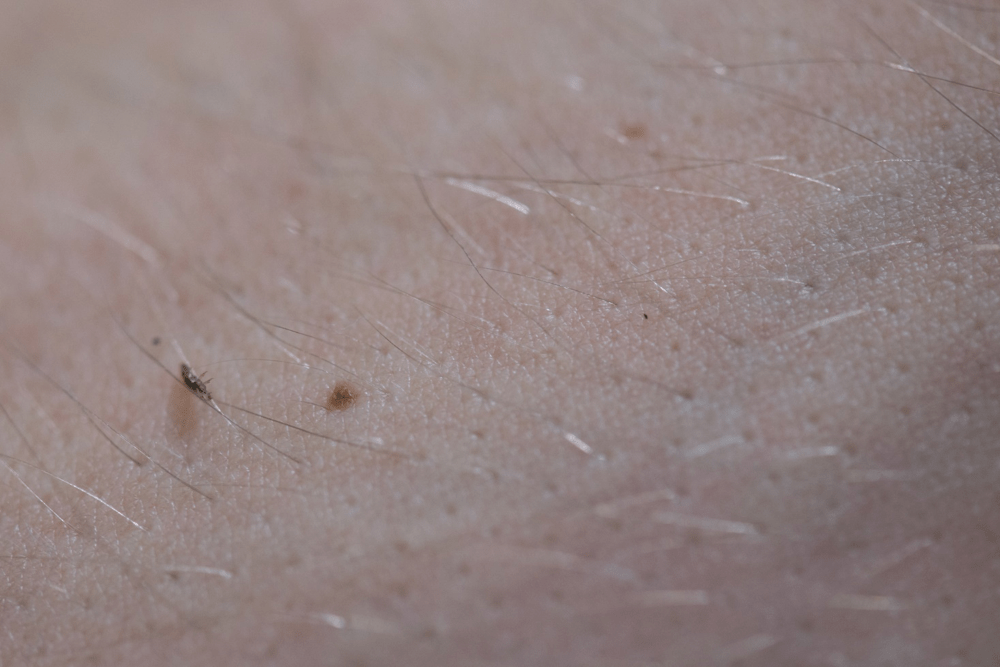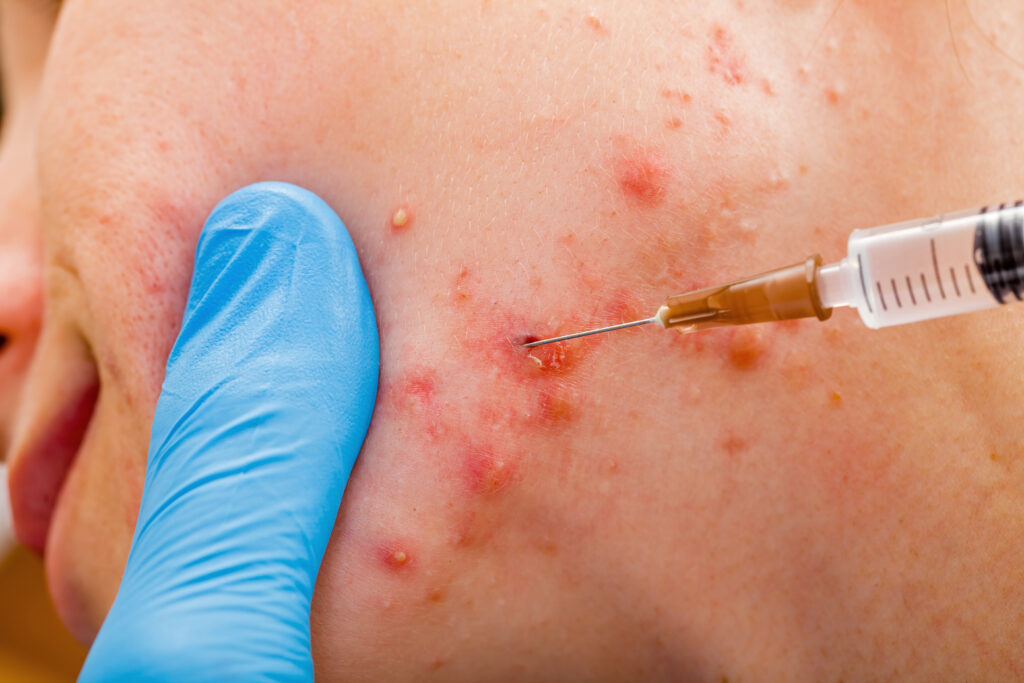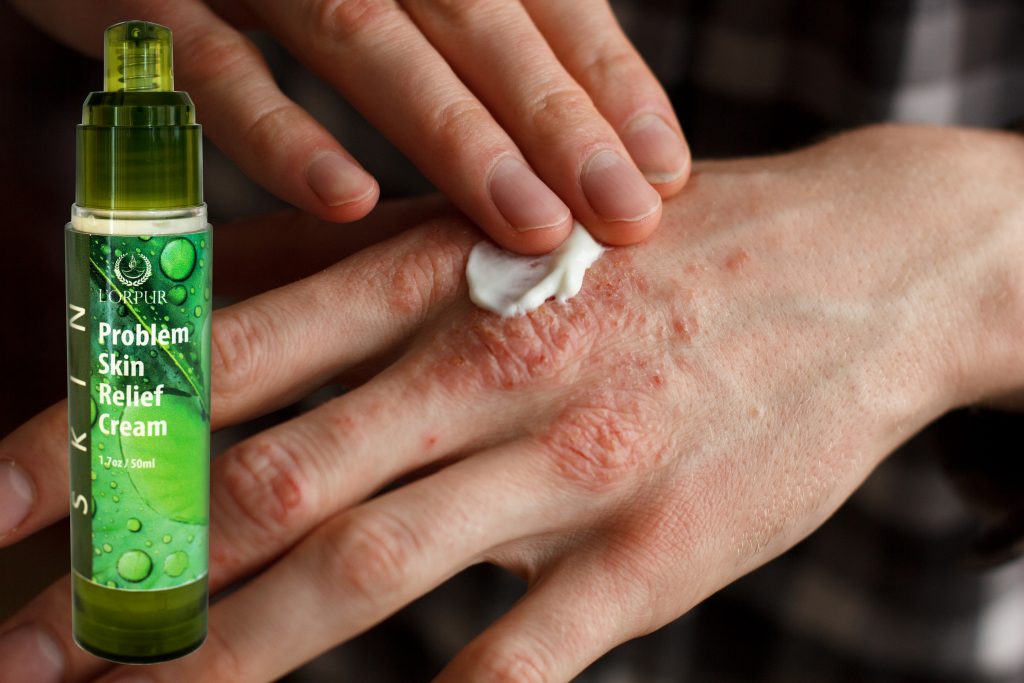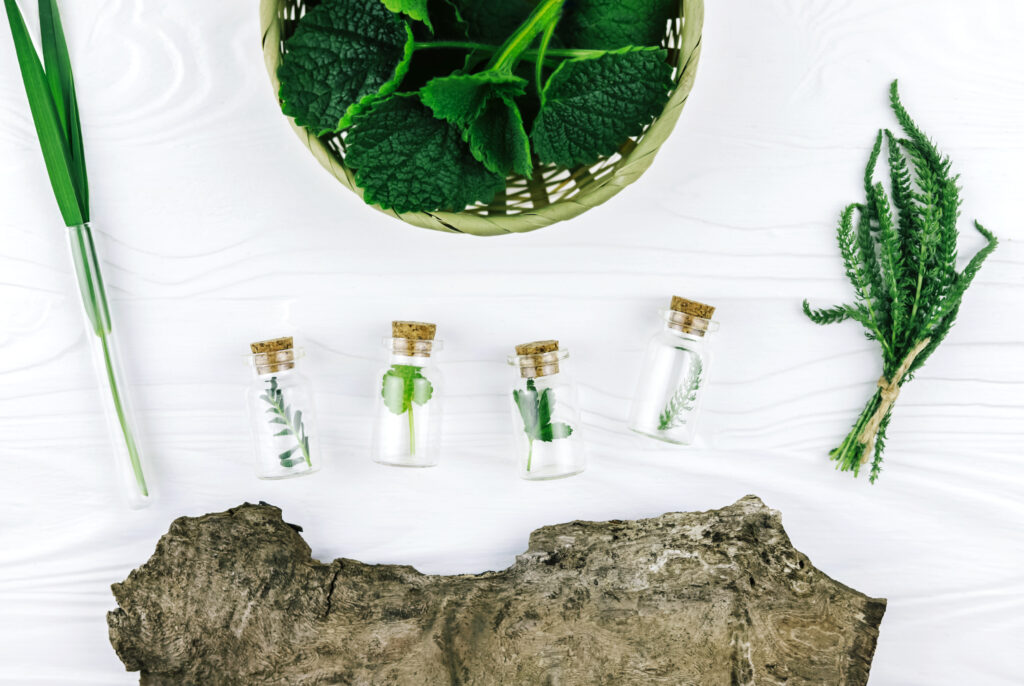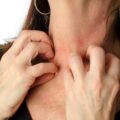If there’s something strange on your skin
Who you gonna call? Essential Oil germ busters
If there’s something weird on your skin
And it don’t look good
Who you gonna call? Essential Oil germ busters!
I wish you guys could hear me croon that one but it’s going to be very hard on your ear drums, I really do have such a sonorous voice, NOT!
So, I will spare you the punishment of hearing me sing and start talking about the topic of the day.
I am Olivia folks, your neighborhood essential oil potion maker and today we are going to whip up blends that will kick all those disease-causing germs out of your body and your home.
So, brew yourself a nice cup of tea, sit back and get ready for Olivia’s Ultimate Guide For Using Essential Oils To Treat Skin Infections. Let’s start with a question…
What’s with your skin and infections? It’s like a match made in hell!
Your skin is not just the largest organ of your body (I know about the discovery of the interstitum but for now your skin is still the king), it also happens to be its first defender. We are talking about the foot soldiers here folks, those that have to face the full brunt of an enemy attack.
Covering over 20 square feet and contributing to about 8% of your body weight, this organ not only keeps the critters out but also defends the body against the detrimental effects of pollutants and other harmful environmental stressors and helps to regulate the body temperature.
Basically, putting up with sweat, free radicals, harmful critters and back stabbing germs that go from innocuous to dangerous, is all in a day’s work for your skin. To add to it, because it happens to be the outermost organ of your body, it also faces the risk of nicks, cuts, scratches, scrapes, burns and more.
But not the one to be subdued easily, your skin still holds the fort like a champ till you open a pathway for the critters to get into the deeper dermal layers. Yes, I am talking about all those small nicks and cuts here.
Typically, most skin infections start with small wounds and lacerations, ones that you dismiss as too tiny to create trouble.
Of course, there are also instances when the critters wiggle their way into the deeper areas of the skin without a wound to facilitate their entry. Moreover, the infection can also come from the inside of the body.
Because your skin is constantly fighting a war against both internal and external harmful elements, but receives the leftovers in terms of nutrition, it is bound to be more susceptible to attacks. And that is why, skin infections send a whopping 14 million people in the US to the doctor’s office each year.
In fact, most people have experienced a skin infection at least once in their lives; that is truly how common and wide spread skin infections are.
What Exactly Are Skin Infections?
Any infection involves an attack launched by foreign bodies on an organ. As far as skin infections go, they can start from the outside, in which case, the skin is the only organ infected, or they can start from the inside, in which case, your skin will be one of several organs that are affected.
If the germs are kicked out of the organ/body before they can do too much harm, there isn’t any lasting damage, but in some cases, your immune system cannot fight the invaders on its own and this is when outside help is needed. Depending on the starting point and the spread, infections can be classified into 3 types:
Primary:
Usually, a single organism is involved in a primary infection and it occurs on unbroken and normal skin.
Simply put, there are no lesions or wounds or other openings that allow the germs into the deeper dermal layers.
Typically, Streptococcus pyogenes, Staphylococcus aureus, coryneform bacteria are the culprits involved in primary infections. Common examples of a primary infection are impetigo, boils and folliculitis.
Secondary:
As the term suggests, this is a superimposed condition that involves damaged or diseased skin, which allows germs access to the deeper dermal layers.
The pathogens that cause secondary infections can be the same as those that lead to primary infections, or they can be opportunistic germs that normally live harmlessly on the skin, but create trouble the minute the bust through the skin’s barrier.
Because deeper dermal layers and even fatty or muscle tissue gets affected in this type of infection, it may be more serious than a primary skin infection.
Systemic:
In this type of infection, the skin is just one of the organs to be impacted by the critters.
Typically, these infections are caused by viruses and can involve multiple organs. Often systemic infections can prove to be hard to tackle as they leave the body vulnerable to a secondary infection and impact vital organs and systems like the kidneys, the lungs and even the brain.
A critter here, a critter there, these critters are just about everywhere!
To add to the problems of your skin, there isn’t a germ out there that won’t attack if given the chance. You name it; from bacteria to viruses and from fungus to mites, they will all have a go at your skin if allowed to do so.
And if that is not enough, many of these are permanent dwellers on your skin; particularly some species of bacteria. Normally, these critters play the role of good guys or let me rephrase, the bad guys who keep the other bad guys out.
But, like I mentioned, the minute the find the opportunity to create trouble, they don’t shy away from living up to the true nature.
Moreover, these pathogens have varying biology. For instance, bacteria are single cell organism that can also work in groups to launch a more devastating attack while viruses are a strand or particle of nucleic acid that infect and start living inside a host cell. In contrast, fungi are unicellular or multicellular parasitic organisms that live off their hosts, as are microscopic mites.
So a drug that works against one does not work against the other. Take a look at some of the most common types of skin infections caused by these pathogens include:
Bacterial infections:
These are usually treated with oral or topical antibiotics and are transmitted through direct contact or contact with an infected substance or object.
- Impetigo: A skin ailment that hits young kids, impetigo leads to the appearance of oozing and itchy blisters on the face and other parts of the body.
- Cellulitis: Although the skin and muscle tissues on the legs are usually targeted in this infection, the painful redness and inflammation can also occur on other parts of the body.
- Boils: These tender, red and painful bumps develop when the infection spills over from the hair follicles to the deeper tissue. Pus usually accumulates in the lesions.
- Folliculitis: The infection is limited to the hair follicles in this case and leads to red, painful and pimple like bumps to appear.
Viral infections:
These infections come in all forms including fluid filled lesions, rash, general redness, itching and more.
They can be mild and cover only one small area of the body or severe and produce symptoms all over. Viral infections spread through direct contact, contaminated objects and the airborne route.
- Chicken pox and shingles: The blister-like and itchy rash that covers the whole body is caused by varicella zoster virus. The infection is not usually life threatening but it is highly contagious. Shingles are caused by the reactivation of the same virus that causes chickenpox. However, the painful rash is not as contagious as chickenpox.
- Molluscum contagiosum: Common in young kids, this skin infection manifests in the form of flesh colored, firm and painless bumps that can cover a small area of the skin or even the whole body and can prevail for 6-12 months. Although it spreads easily, the condition is considered harmless.
- Warts: Another harmless condition in which the infection is limited to the top dermal layers, this one leads to fleshy skin growths that can show up on any part of the body. The viruses that cause warts are highly contagious and although in kids the condition resolves quickly, it tends to linger in adults.
- Cold sores: Also known as oral herpes/fever blisters, the unsightly, yellow, fluid- filled blisters are caused by the herpes simplex virus (HSV-1). The lesions are usually seen around the mouth and the nose but can appear on other areas of the body as well, particularly if you suffer from eczema. Over 80% people in the US suffer from this recurring infection. Although genital herpes is caused by the HSV-2, in rare cases, an HSV-1 infection can also lead to genital herpes.
Fungal infections:
Fungi are primitive creatures; think mushroom and moss, so they hit the first organ that they can get to, usually the skin and/or the lungs. Hence, these prove to be the starting point of most fungal infections.
But this does not mean that the infection cannot spread to the other parts of the body, particularly the blood stream, which is when things get life threatening. Fungal infections get transmitted through direct contact as well as through infected air, water and soil. Common fungal infections include:
- Athlete’s foot: These critters don’t discriminate between ages and genders, and you don’t have to be an athlete to suffer from the condition. All that is needed is a wet and warm environment in between the toes to give this fungus a thriving environment. Symptoms of the infection include a scaly and itchy rash that can ooze and cause a burning sensation when you scratch too hard.
- Ringworm: Don’t let the name confuse you, there is no worm involved in this infection. Known as dermatophytes, these are the same fungi that cause athlete’s foot. These organisms target the skin, the scalp and even the nails. The infection is typically superficial and causes intense itching, redness, rash and scaly patches with an inflamed red ring around them, which is what earned the condition its name.
- Candidiasis: Yeast infection is caused by unicellular fungi; in fact, 20 species of them. They usually live on the skin without causing harm. But, when an imbalance hits, these critters are only too happy to cause trouble.
- Nail infections: This is another common condition in which the fungi attack the nail bed and cause visible nail deformities.
Parasitical infections:
These are usually transmitted through close direct contact or through use of contaminated things like clothes, towels and combs, etc. The most common of these infections are:
- Scabies: The intense itching and scaling of this condition are attributed to microscopic mites called Sarcoptes scabei.
- Lice: These parasites are visible to the naked eye and can be seen crawling about, feasting on your blood. You can get head lice, pubic lice (crabs) or body lice. Like blood sucking insects, these mites cause intense itching where they bite.
With so many infectious critters out and about, how come more people don’t suffer from a skin infection?
Well actually, more than half the population has suffered from at least one bout of skin infection in their lives. But, just how susceptible you are to those infectious critters depends on 3 factors:
1. Your immune system:
If your body’s defense system is firing on all 4 cylinders, the critters won’t be allowed in. Yes, there will be a few symptoms, but the germs will fail to make a dent and you won’t really need outside help to deal with the attack.
On the other hand, if your immune system is not up to par, even a simple, normally harmless infection, can turn dangerous. For instance, a normally self-resolving and self-limiting skin infection can cause a lot of harm to individuals who suffer from ailments that impact the immune system like AIDS/HIV, diabetes and those who have been through chemotherapy or are on immunosuppressant drugs .
2. Integrity of the skin’s defensive barrier:
Made of fats and dead cells, the topmost layer of your skin is the barrier that keeps critters out. So, when the integrity of this defensive layer is compromised, your skin and your body becomes vulnerable to infections.
Not only wounds and lacerations but also extreme dryness, like that caused by eczema and psoriasis, can allow germs to get to the deeper dermal structures. Similarly, any kind of puncture, such as those caused by injections or bug bites can create an opening for germs.
3. The normal dermal flora and fauna:
The bacteria and fungi that normally live on the surface of the skin help to keep the bad critters in check by preventing their super-colonization. Any imbalance in the number of these microorganisms can allow pathogenic germs to thrive and create trouble.
The Symptoms Of Skin Infection
Symptoms of skin infections can vary significantly depending on the condition that you are dealing with. While some infections do not lead to any discomfort but do have visual manifestations, like warts, others can cause a significant amount of pain, like cellulitis. Usually, the symptoms of skin infections include:
- Intense itching
- Redness and inflammation
- Tenderness
- Raised patches
- Rash
- Boils
- Pimples
- Inflamed hair follicles
- Oozing boils/rash
- Extreme dryness and skin flaking
- Swelling and tenderness
- Skin that is hot to touch
- Red sores
- Tender bumps
- Pus filled or fluid filled lesions
- Yellow or brown crusting over ruptured sores
- Rash that spreads to other parts of the body
- Pus or fluid leaks out of a lesion or a cut/wound
Should You See A Doctor For Your Skin Infections?
Most superficial skin infections can be treated at home but if you are dealing with a serious infection, a visit to the doctor’s is definitely recommended if not for anything else, to at least get an accurate diagnosis of the condition.
Older individuals, kids, pregnant women and those who are already battling another health condition should definitely seek medical attention even for superficial skin infections. Also, if you have any of the symptoms listed below, it’s time to see your doctor.
- A rash or skin redness or itching that spreads to other parts of the body.
- Fever and chills (temperature above 100.4 degrees F).
- The rash or inflammation becomes painful.
- Swelling that increases and spreads to other parts.
- If you develop sores that look like blisters.
- Increase in the size/number of the sores or blisters.
- Clear signs of swelling, inflammation and tenderness around the infected area.
- Fluid or pus accumulation in blisters.
- Red streaks moving away from the site of infection and towards the heart.
- The rash, blisters or boils are impairing day to day life.
- The scratching has resulted in a wound that does not heal within 5-7 days.
- Signs of infection like itching, redness, flaking prevail for more than a week.
- The skin infection has developed while you are pregnant or are breast feeding.
- An overall feeling malaise.
- Unexplained fatigue, loss of appetite, nausea.
- Recurrent and/or persistent infection.
The problem with skin infections is that they typically start off small. This lulls people into complacency and makes them assume that leaving the rash alone will make it go away.
Well, let me put it this way – infectious critters and getting stronger and more resilient by the day. Plus, they are rapidly adding new members to their folds; case in point, the dreaded and often fatal flesh eating bacteria.
So, it’s best to err on the side of caution when dealing with a skin infection and give your body some help to deal with the invasion.
What Is The Typical Treatment Approach For Skin Infections?
For a superficial skin infection, doctors prefer to stick with topical preparations. If the infection does not respond to these formulations or has already reached deeper dermal layers, then you will be put on oral meds.
Whether oral or topical, the drugs are prescribed on the basis of the type of microorganism that has caused the infection. As far as side effects are concerned, oral meds carry a greater risk of causing them than topical formulations. That said, the treatment options will usually include:
Antibiotics:
I am done telling people that antibiotics have been done to death. Why even folks from the medical community will second me on this one. I am not saying that antibiotics are bad per se but the fact is that their rampant misuse and overuse have led to the birth of antibiotic resistant strains. If we don’t stop already, the future looks bleak.
Of course, antibiotics are needed when the infection is serious, but I truly believe that these meds should be used as the last resolve and not as the first line of treatment.
Unfortunately, doctors often end up prescribing them even when they are not certain that a particular ailment calls for their use. So don’t be surprised if you are sent home with a prescription of oral or topical antibiotics for your skin infection.
Normally, you may be given one of these seven drug types: penicillins, cephalosporins, fluoroquinolones, macrolides, tetracyclines, sulfonamides or aminoglycosides.
Now, let me tell about the side effects of these drugs. When used topically, you may escape with some redness, inflammation, rash, itching and burning at the site of application.
Unless you are allergic to a particular drug, it is rare to experience more serious side effects with topical formulations but oral antibiotics are another story. Their side effects can include:
- Gastrointestinal issues including nausea, vomiting, diarrhea and cramps.
- Increased photosensitivity while on the antibiotics (particularly tetracyclines).
- Fever not above 100.4 degrees F (typically resolves with medication in 24-48 hours).
- Tooth discoloration, which may be permanent in children.
- Flu like symptoms with rapid development and spread of painful blisters and rash (Stevens-Johnson syndrome). This is a serious side effects that requires immediate medical attention.
- Leukpoenia, which is a decrease in number of white blood cells.
- Thrombocytopenia, which is a decrease in the level of platelets.
- Irregular heart beat and low blood pressure.
- Tendonitis and in some cases, tendon rupture.
Antivirals:
Altrex is an antiviral drug generally used to treat oral or genital herpes and shingles. For other viral skin infections, doctors prefer to go with a corticosteroid ointment and an antibiotic cream, just in case a secondary infection hits (notice how the antibiotic is used when it’s not actually needed). The side effects of this drug include:
- Dizziness
- Fatigue
- Headache
- Stomach upset
- Vomiting
- Depression
- Mood changes
- Joint pain
- Sore throat
- Skin rash
- Nasal congestion
- Menstrual pain
- Increased thirst
- Easy bruising
- Urinary issues (low urine output)
- Red spots on the skin not linked to oral herpes or chickenpox
Antifungals:
The most commonly prescribed antifungal drugs include nystatin, terbinafine and fluconazole. Although their side effects are generally considered mild enough for these to be available OTC, in some people, these drugs do lead to serious liver problems. Other side effects include:
- Headaches
- Gastrointestinal problems
- Rash
- Joint and muscle pain
- Mouth sores
- Taste problems
- Loss of appetite
- Redness, inflammation and pain at the site of application.
Along with these, you may also be given corticosteroid ointment, which come with their own share of terrible side effects.
Although these lists of adverse reactions should suffice to make most people consider alternative therapies, many continue using the drugs because they are not sure if natural methods will work. And, that is what brings me to my next question.
Recommended Natural Product For Skin Infections
If you are after a natural product with no side effects for all your skin-related issues, look no further. The L’orpur Problem Skin Relief Cream is the perfect remedy that will deal with the nasty skin problems!
Can Essential Oils Really Help As Much Or More Than Anti-Pathogenic Drugs And Ointments?
Let me tell you what happens before and during a skin infection, and then we can talk about the right course of treatment. At first, these critters start colonizing an area of the skin. I have already discussed the factors that make you vulnerable to such colonization, so I will tell you what happens after that.
The skinny on skin infections:
Once, these germs have the numbers, they start invading the organ/cells, in this case, the skin. In response, your body launches a counter strike. Together, the immune response and the bacterial attack lead to a lot of cellular damage and that is what you experience as the itching, inflammation, burning, pain and swelling.
Those critters create a lot of trouble:
Furthermore, these bacteria release toxins when they die and as they proliferate. These toxins break the bond between the dermal layers creating pockets that fill with fluids from the cells and that is what causes rash and tiny fluid filled blisters. The war goes on and your skin continues to suffer till the infecting microorganisms are not completely eliminated.
A game plan to beat the germs:
When you consider the chronology of events, it isn’t hard to chalk out a treatment plan. Ideally, it should include a substance that stops the colonization and proliferation of the pathogens, detoxifies the cells and the dermal layers, curbs the inflammation, tackles the itching, pain and burning sensation, increases the pace of healing and overall soothes the skin.
Now, if you rely on modern medicine, you’ll end up with a dozen drug and ointments to achieve all of these effects. But, things work differently when you are in Mother Nature’s territory. You can get all of these benefits with a single blend of the right essential oils.
I’ve spoken about the soothing and healing effects of these aromatic compounds before. So, I won’t repeat myself and bore you. Instead, I am going to tell you about the ability of these oils to deal with the infection causing germs.
Essential oils are the heavy artillery:
Without even a hint of exaggeration, I am going to say that many of these essential oils are actually far more effective and potent than anti-pathogenic drugs, when it comes to dealing with skin infections. In fact, a lot of these aromatic extracts can singlehandedly fight bacteria, fungi and viruses. No pharmaceutical drug currently known to mankind can do that!
Some essential oils are so strong that they can even kill microorganisms that have become immune to drugs. Yes, I am talking about the dreaded antibiotic resistant strains here. Plus, you get all the ancillary benefits like quick healing, rapid drying up of wet and oozing sores and detoxification.
Above all, there are no side effects and you can use essential oil blends for as long as you like. So, these extracts are also effective against recurring skin infections.
Don’t You Want To Know About The Best Essential Oils For Skin Infections?
With a roaring round of applause, ladies and gentlemen, please welcome the essential 7 that can and will send skin infections packing.
1. Oregano:
This superstar needs no introduction because there isn’t a critter out there that this bad boy cannot bring down. I am talking about the bazooka of germ killing essential oils here; one that works on bacteria, fungi and viruses. The hot oil owes its critter killing powers to carvacrol, a phenolic compound that is one of its main constituents.
Carvacrol is clinically proven to be more effective than 18 commonly used antibacterial and antiviral drugs. When diluted with an appropriate carrier oil and blended with other essential oils, this aromatic extract can be used to fight just about any type of skin infection.
2. Peppermint:
This stimulating oil is one of the most powerful antifungal agents in nature and boasts of impressive antiviral abilities. Furthermore, the cooling effect of the oil helps to relieve the itching, redness and burning caused by skin infections.
Peppermint essential oil is a fantastic system soother and regulator that tones down the release and the impact of histamines. So, the minute you use this essential oil, you win half the battle against skin infection and inflammation.
3. Tea tree:
With nearly 100 phytocompounds to its credit, it’s no wonder that tea tree oil is one of the most popular germ fighting essential oils. Its ability to kill bacteria is at par with OTC silver and chlorhexidine formulations.
Although the oil is exceptionally potent when it comes to preventing bacterial colonization, it is gentle on the skin and can be used on children, by the elderly and by those with sensitive skin. Moreover, tea tree oil is also a powerful antifungal and antiviral agent.
4. Palma rosa:
These sweet-smelling oil may seem like an unlikely addition at first, but wait till you hear about its antifungal powers. Of all pathogens, fungi are the most stubborn. So, it takes the longest to push these critters out of the system.
Often several weeks of regular topical treatment is required to experience discernible benefits. But, when you put palmarosa essential oil to use, those results can be seen in just 24 hours. Additionally, the oil soothes inflamed skin and boosts the regeneration of skin cells.
5. Lemon eucalyptus:
This is another antifungal and antibacterial powerhouse that also helps against inflammation and the rash/blisters caused by skin infections. The gentle oil with a lemony scent is effective against both unicellular (yeast) and multicellular fungi.
Furthermore, it also brings analgesic properties to the mix, which help to relieve the discomfort that comes with infectious dermal diseases. Lemon eucalyptus essential oil also helps to speed up the wound healing process.
6. Cinnamon:
The fragrant oil derived from the bark of the cinnamon tree is the most powerful antibacterial, antifungal and antiviral agent in nature. In fact, the dark colored oil is known to kill bacterial colonies immediately on contact. Its active component, cinnamaldehyde, is particularly effective against all types of staph induced skin infections.
In a 2016 study, it was found that cinnamon essential oil is more potent at handling fungal infections caused by candida albicans than most pharmaceutical preparations. Moreover, this oil also helps to deal with parasitic mites and organisms that cause skin problems.
In addition to these benefits, cinnamon essential oil also brings strong antioxidant properties to the table. The antiseptic oil is a powerful detox agent that significantly increases the natural speed of healing.
7. Thyme:
The combination of thymol, carvacrol, beta-caryophyllene and camphene give this aromatic extract its incredible abilities to fight bacterial, viral and fungal infections. Thyme essential oil helps to heal primary skin infections and keeps secondary infections away.
It enhances the body’s natural ability to heal itself by increasing circulation and removing toxins from the cells. An immune booster and antiseptic agent, thyme oil also has analgesic properties.
The soothers and the healers: In our blends, we are also going to use essential oils of lavender, geranium, lemongrass, turmeric and roman chamomile. These oils amp up the healing ability of the body, curb inflammation and soothe the skin.
The carriers: Macerated oils of neem and calendula, extra virgin olive oil are highly preferred for skin healing blends because they offer additional antiseptic and antimicrobial effects.
Top 8 Essential Oil Recipes For Skin Infections
1. Bacteria buster blend
Ingredients:
- 40 ml neem (Indian lilac) macerated oil (you can buy this online or make some of your own by using sesame seed or coconut oil and neem leaf powder)
- 3 drops each of oregano and cinnamon essential oils
- 5 drops turmeric
- 5 drops peppermint
- 8 drops geranium
Method:
Mix the carrier and the essential oils together and store in a dark colored glass bottle. To use, wash the affected parts with a skin-friendly antiseptic soap. If you are treating a small area (1-2 inches or a few blisters/sores), soak a Q tip in the blend and apply on the skin.
When treating a larger area, soak a small piece of cotton wool in the blend and apply on the affected areas. Leave the blend on your skin for at least 2-3 hours. If you can tolerate it, use the blend overnight. In the morning, wash with luke warm water. Use twice a day till the infection heals completely and then use once a day for 7-10 days to prevent a relapse.
2. Fungus fighter blend
Ingredients:
- 40 ml extra virgin olive oil or macerated neem oil
- 10 drops palma rosa
- 5 drops lemon eucalyptus
- 4 drops each of thyme and peppermint essential oils
Method:
Mix the oils and store in an amber glass bottle. For fungal skin infections, usage directions are the same as above. For nail infections, add a teaspoon of the blend and ½ cup of salt to a tub of hot water (not boiling but hot to touch) and soak your feet in it for 15-20 minutes.
3. Virus wiper blend
Ingredients:
- 40 ml macerated calendula oil
- 2 drops each of cinnamon and oregano essential oils
- 6 drops lavender
- 5 drops tea tree
- 4 drops turmeric
Method:
Preparation and usage as recipe 1.
4. Germs away hand and body wash
Ingredients:
- 50 ml regular handwash/bodywash or liquid Castille soap
- 10 drops each of tea tree, palma rosa and lemongrass essential oils
- 10-15 ml distilled water (optional)
Method:
You will need a bottle that can hold 100 ml liquid. Pour 50 ml of your regular handwash/body wash or liquid Castille soap into the bottle. Use a dropper to add the essential oils to the soap. Top the container with 10 ml of distilled water to get the right consistency. Put the cap back on and give the bottle a good shake to mix the soap, the oils and the water. Use as you would any antiseptic hand wash or body wash.
If you have been in contact with somebody who is suffering from a skin infection or if someone at home is down with a dermal infection, use this body wash at least once a day and use it as a hand wash every time you come in contact with the patient or something that he/she has used.
5. Clean and healthy skin bath blend
Ingredients:
- 1 cup Epsom Salts
- 1 tbsp milk (dairy or plant)
- 7 drops each lavender and palma rosa essential oils
- 3 drops each tea tree and lemon eucalyptus essential oils
Method:
Run a warm bath and add Epsom salts to the water when the tub is half full. Mix the essential oils with the milk and add the blend to the water. Once the tub is full, agitate the water to disperse the oil droplets. Soak yourself in this healing, germ fighting bath for 15-20 minutes to prevent and treat skin infections.
6. Healthy and happy skin lotion
Ingredients:
- 50 ml Regular unscented body lotion or
- 1:3 mixture of shea butter and a carrier oil of your choice
- 8 drops each of roman chamomile and lavender essential oils
- 5 drops tea tree
- 2 drops cinnamon
- 3 drops each of basil and rosemary essential oils
Method:
Mix the essential oils in a small glass bowl and add them to unscented body lotion or even your regular body lotion. Just remember to whisk well to ensure that the essential oils are mixed properly with the carrier. If using shea butter, mix it with the carrier oil and melt in a double boiler till you get a homogenous mixture of lipids. Add the essential oil blend to this mixture of lipids and whisk using a chopstick or a glass stirrer.
Regardless of the base used, you will need to store this lotion in a dark glass container or bottle. Use as you would any normal body lotion. This blend is a potent antimicrobial formulation and it’s amazing for the health of your skin.
7. Rapid healer paste
Ingredients:
- 1 tsp Neem leaves powder
- ½ tsp Green tea (matcha or green tea leaves ground to a powder)
- A pinch of turmeric or 1 drop turmeric essential oil
- 1 tbsp Apple cider vinegar
- Almond milk as required
- 1 drop each of oregano, tea tree and cinnamon essential oils
Method:
Remove the powders in a glass bowl and add apple cider vinegar to them. Mix well before adding enough almond milk to make a smooth paste that has the consistency of a face mask/cake batter. Add the essential oils to this paste and whisk well for about a minute. You do not want the oil droplets to float on top.
Apply a medium thick layer of the paste on the affected parts and allow it to dry on your skin. Wash off with warm water. This formulation works exceptionally well on oozing wounds/sores and boils that have not come to head as yet.
8. Parasite push out blend
Ingredients:
- 50 ml any carrier oil of your choice
- 1 tsp of camphor gum powder (this is a natural product and it can be found online)
- 10 drops each of eucalyptus and peppermint essential oils
Method:
Mix the carrier oil and the essential oils together and add the camphor gum powder to this blend. Store in a dark glass bottle. To use, shake the bottle to mix the ingredients and apply to your scalp or on the affected parts of the body. This blend is incredibly effective against scabies and lice.
For scabies, keep it on the skin overnight. For lice (pubic, hair and skin), apply and keep it on for 2-3 hours and wash off with warm water. The parasites literally go berserk and run for their lives once this blend goes to work, so you may feel intense itching. After application, wait for about 15-20 minutes and use a fine toothed comb to get the lice out of your hair and simply rub off skin and pubic lice by using an old towel or face wash cloth.
Home Treatment For Skin Infections
Although I believe you should always have your all-purpose essential oil kit handy, I know there are times when help is not immediately available. So, here are 5 quick fix remedies that can be found in the pantry or the refrigerator and which can be used while you get the essential oils you need.
- Mash a clove of garlic and a few basil/rosemary/oregano leaves/sprigs to a paste. It’s best to use a mortar and pestle for this instead of a food processor. Once you have the paste ready, apply in a thick layer on the affected parts and cover with a sheet of gauze to hold the paste in place. Keep it on the skin for 15-20 minutes and then wash it off with cold water. The paste does sting a bit, which can actually help to deal with the itching.
- Deseed ½ a tomato and add 1 tbsp if Epsom salt to it. Grind in a food processor and apply the puree to the affected area. The natural acids in the tomato and the minerals in the Epsom salts help to combat bacterial colonization.
- For fungal infections, use strong brewed green tea with apple cider vinegar in 1:1 proportion as a salve. Apply on the affected parts and allow it to dry on the skin or add about ½ cup of the mixture to a small tub filled with water and soak your feet in it.
- Mix a tablespoon of extra virgin olive oil or coconut oil with ½ tsp of baking soda and apply on the affected parts as you would any antiseptic ointment.
- Cut thin slices of ginger and place on the affected area or mash some ginger and apply the paste on the affected parts. Keep the paste on your skin for 15 minutes and then wash with tap water.
In Conclusion
The one thing to remember when dealing with skin infections is that hygiene is of utmost importance whether you are trying to prevent or treat the condition. Frankly, it isn’t possible to completely avoid contact with these germs because most of these critters are a resilient lot.
In fact, the tiny terrors are known to not only brave the vacuum of space but also thrive in it. So, they are always going to be around. You can pick them by swimming in a contaminated pool/water or even by walking on floor that has germs from another host. Your only option is to kill them or at least stop them from multiplying before they cause trouble and that is where hygiene helps.
Additionally, I cannot stress enough on how important it is to fortify your skin and your body in general from ailments by eating healthily. Nutritional gaps weaken your immune system, cause an imbalance in the body and create passages for these germs to enter your skin and other organs.
Simply put, I can’t say much about godliness but cleanliness and healthiness sure are next to happiness. And, on that note, here is wishing you all a germ-free, healthy and happy life!

